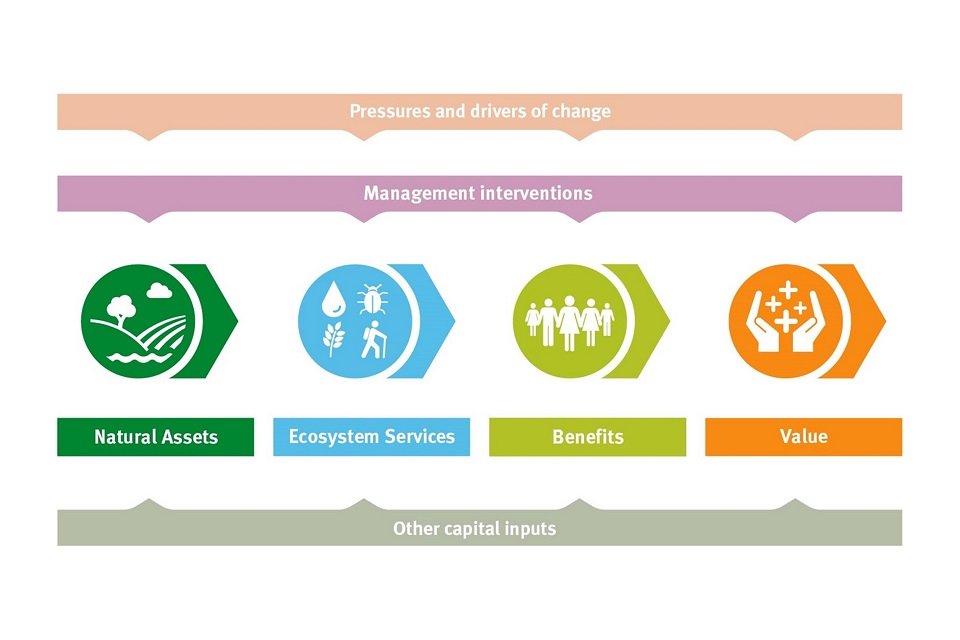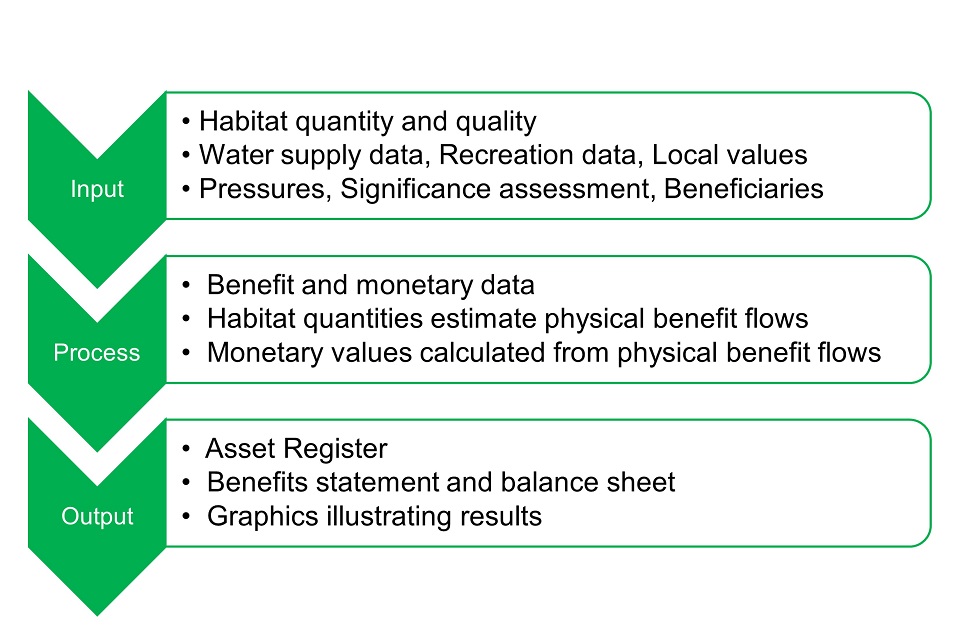Appendix E: Natural capital approach
Published 29 November 2022
Applies to England
Appendix E to Investment requirements for England’s river basin management plans.
This Appendix provides details of the natural capital register and accounting work and tool used by the Environment Agency.
Introduction
Natural capital is the country’s stock of ‘environmental assets’ such as water, soil, air, and minerals that provide valuable goods and services (benefits) to people such as providing clean air and water, food and recreation as well as supporting sustainable economic growth. Figure 1 shows the flow from natural capital (assets) to the benefits (value) people derive from it.
Figure E1 Natural capital assets, ecosystem services, benefits and values

At the heart of a natural capital approach is the understanding that nature underpins human wealth, health, wellbeing and culture. Recognising the complex ways in which natural, social and economic systems interact enables the use of better evidence to support decisions that protect and enhance natural capital so that it can continue to deliver the services and benefits we all need.
How a natural capital approach supports river basin planning
A natural capital approach provides a practical framework that encourages collaboration and improves integration of different needs during planning, decision-making and delivery for a place.
1. It brings nature into economic decision making enabling the use of better evidence to support better decisions that protect and enhance nature.
2. By considering the multiple benefits we all get from nature it can leverage more investment in nature-based solutions.
3. It encourages collaboration and improves integration of different needs during planning, decision-making and delivery for a place.
Natural capital accounting
A natural capital register and account presents the value, quantity and quality of natural resources in a place. The outputs can change the way people see the environment and the value it gives to all our lives and the economy. It helps to monitor net gain, or net loss, of natural assets. Natural capital accounting encourages integrated and transparent thinking about the wider consequences of environmental decision making.
A natural capital register and account can:
- start new conversations about the value that the local natural environment provides to the local economy
- help to establish an asset and values baseline for a place
- support prioritisation and place based planning
The Environment Agency natural capital register and account tool (NCRAT) provides a way to create place-based natural capital registers and accounts, using built-in benefit and valuation data. It uses information on the natural capital assets in a place to estimate the flow of services from the assets and applies monetary values to some of those provided.
Figure E2 The register and account tool flow chart

The values presented are intended to show a partial view of the irreplaceable services that nature provides to the local economy for free, or little input. It is not a price, or a value for exchange. There are many services and functions of nature that are not valued in this tool (for example noise regulation; pollination; flood regulation by saltmarsh and wetlands for example) and there are many ecosystem services that cannot be effectively valued in any account such as the value of biodiversity.
Thirteen broad ecosystem services are included in the tool for which robust and reliable benefit and value information is available. Four of which have been sub-divided, creating twenty-two in total (as detailed in Table E1). The values represented in the benefit statement reflect what input data is available for a given place and may be limited by geographic scale and data availability.
Table E1: Ecosystem services quantified in the tool with the physical and monetary flow measure
Category: Provisioning
| Ecosystem service | Physical flow measure | Monetary flow measure |
|---|---|---|
| Agriculture - arable | Yield of arable production | Gross margin |
| Agriculture - livestock (dairy) | Yield of livestock (dairy) production | Gross margin |
| Agriculture - livestock (meat) | Yield of livestock (meat) production | Gross margin |
| Fish landings* | Volume of fish landings | Net profit |
| Water supply (public water supply) | Abstracted raw water quantity | Resource rent |
| Water supply (energy use) | Abstracted raw water quantity | Not valued |
| Water supply (other) | Abstracted raw water quantity | Marginal value |
| Timber | Volume of timber removals | Stumpage price |
| Renewable energy* | Hydro-generation production | Resource rent |
*Ecosystem services not included in the benefit statement for North West River Basin District case study
Category: Regulating
| Ecosystem service | Physical flow measure | Monetary flow measure |
|---|---|---|
| Climate regulation | Net CO₂ sequestered | Abatement cost |
| Air quality - PM2.5 | PM2.5 absorbed | Avoided cost (treatment and productivity) plus welfare value |
| Air quality - SO₂ | SO₂ absorbed | Avoided cost (treatment and productivity) plus welfare value |
| Air quality - NO₂ | NO₂ absorbed | Avoided cost (treatment and productivity) plus welfare value |
| Air quality - O₃ | O₃ absorbed | Avoided cost (treatment and productivity) plus welfare value |
| Hazard regulation | Properties in flood zone 3 | Avoided damage cost, or replacement cost of water storage depending upon option selected |
Category: Cultural
| Ecosystem Service | Physical flow measure | Monetary flow measure |
|---|---|---|
| Recreation | Number of visits to open spaces | Welfare value |
| Recreation (children) | Number of visits to open spaces | Not valued |
| Physical health | Number of active visits to open spaces | Avoided treatment cost |
| Education* | Number of nature-based educational visits | Opportunity cost |
| Volunteering* | Number of nature-based volunteering days | Replacement cost |
*Ecosystem services not included in the benefit statement for North West River Basin District case study
Category: Bundled*
| Ecosystem Service | Physical flow measure | Monetary flow measure |
|---|---|---|
| Water quality - rivers, coastal, lakes and transitional waters | not applicable | Welfare value of good water quality |
*Bundle is defined in Enabling a natural capital approach (Defra, 2020), as an ecosystem service which “can include more than one service or a combination of use and non-use values. Currently includes: amenity, biodiversity, soil quality, water quality, landscape and non-use benefits.”
Benefits are categorised according to an ecosystem service classification that incorporates some abiotic elements:
(i) provisioning services (the production of physical goods people consume such as food and water)
(ii) regulating services (ecosystem processes related to climate, air quality, hazard regulation and so forth)
(iii) cultural services (aspects of the natural environment that enrich our lives, such as recreational benefits)
(iv) ‘bundled’ services (that combine multiple benefits)
The contribution of supporting services (the ecological processes and functions such as nutrient cycling that maintain the conditions for life on earth and underpin ecosystem service provision) to benefits flows is embedded within the monetary benefits for provisioning, regulating, cultural and bundled services.
Monetary estimates are given for the annual flow (£m per year at year 0) and a 100-year asset value (£m, present value terms), with minimum and maximum values given when the data allows.

